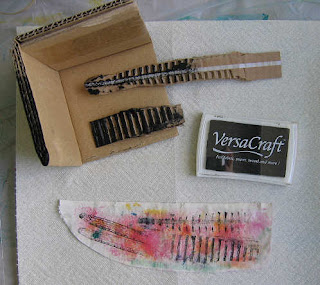
Time to experiment with the next letter in my Surfacing Group's Alphabet challenge. I haven't been getting any sewing done this week, so it was nice to take a break to just sew for a bit. The most common use of the double needle (or twin needle as it is often called) is to make pintucks. So my question was, how can I use this feature to create design or texture on a piece of cloth that could be incorporated into a piece of art?
I bet there are a lot of features on your sewing machine that you've never tried, right? As I paged through my instruction book, I realized just how much my machine will do and I never think to ask it. The instructions reminded me that the machine came with a pintuck foot - specially grooved on the bottom to run over the pintucks I'd be building so that the rows would line up perfectly. The machine also came with an assortment of needles, including a double needle. I think this one is the smallest spacing between needles. For bigger pintucks, there are double needles spaced wider apart.
I just left my machine setting on default. If tension is not adjusted, or is tightened slightly, the ridges will automatically form as you sew. I used scraps of muslin for my base and white thread. Imagine how differently these would turn out if the thread was of a contrasting color.
I started at the top left with traditional rows of pintucking. Then I moved on to see what would happen if I sewed gently curving lines of pintucks. The curves need to be gentle indeed, and as expected, there was some distortion of the fabric between the wide spacing of the tucks. Then I tried crisscrossing single lines of pintucks.
The middle sample shows rows of pintucks following the curved edge of the fabric. Then I ran some lines partway down the piece and crossed them at right angles with another set of pintucks. I like this effect a lot.
Finally, I went back to my curves, but instead of single pintucks, I stitched multiple rows of curved tucks, then tried double rows crossed. I think this technique has a lot of potential, and that there is more that could be done with them. For instance, I think I will try painting the samples to see if I can highlight the tucks with color.
Of course, if you loosen your tension, the fabric will not pull up, and you will have nice even parallel double lines of stitching. That could be useful also, but for today, this was enough.
I bet there are a lot of features on your sewing machine that you've never tried, right? As I paged through my instruction book, I realized just how much my machine will do and I never think to ask it. The instructions reminded me that the machine came with a pintuck foot - specially grooved on the bottom to run over the pintucks I'd be building so that the rows would line up perfectly. The machine also came with an assortment of needles, including a double needle. I think this one is the smallest spacing between needles. For bigger pintucks, there are double needles spaced wider apart.
I just left my machine setting on default. If tension is not adjusted, or is tightened slightly, the ridges will automatically form as you sew. I used scraps of muslin for my base and white thread. Imagine how differently these would turn out if the thread was of a contrasting color.
I started at the top left with traditional rows of pintucking. Then I moved on to see what would happen if I sewed gently curving lines of pintucks. The curves need to be gentle indeed, and as expected, there was some distortion of the fabric between the wide spacing of the tucks. Then I tried crisscrossing single lines of pintucks.
The middle sample shows rows of pintucks following the curved edge of the fabric. Then I ran some lines partway down the piece and crossed them at right angles with another set of pintucks. I like this effect a lot.
Finally, I went back to my curves, but instead of single pintucks, I stitched multiple rows of curved tucks, then tried double rows crossed. I think this technique has a lot of potential, and that there is more that could be done with them. For instance, I think I will try painting the samples to see if I can highlight the tucks with color.
Of course, if you loosen your tension, the fabric will not pull up, and you will have nice even parallel double lines of stitching. That could be useful also, but for today, this was enough.






























